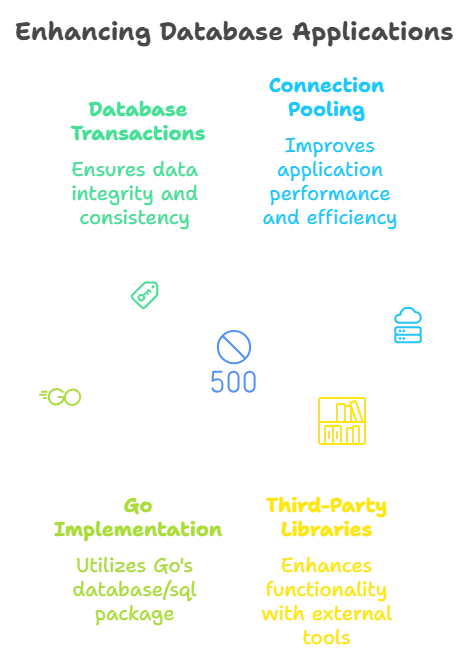Database Transaction and Connection Pooling with Go
In software development, particularly in web applications, interactions with databases are common. A transaction is a fundamental concept in databases that ensures data integrity and consistency. In this section, we'll explore what database transactions are and how they are implemented in Go.
Understanding Database Transactions
A database transaction is a unit of work performed against a database management system (DBMS). It’s a sequence of operations (such as reads and writes) that are treated as a single logical unit of work. Transactions follow the ACID (Atomicity, Consistency, Isolation, Durability) properties to guarantee reliability and consistency in the database.
Implementing Transactions in Go
Go provides built-in support for database/sql package, which allows us to interact with various SQL databases. Let’s see how to implement transactions in Go using this package
package main
import (
"database/sql"
"fmt"
_ "github.com/go-sql-driver/mysql"
)
func main() {
db, err := sql.Open("mysql", "user:password@tcp(localhost:3306)/dbname")
if err != nil {
panic(err.Error())
}
defer db.Close()
// Start transaction
tx, err := db.Begin()
if err != nil {
panic(err.Error())
}
// Execute transactional operations
_, err = tx.Exec("INSERT INTO users (name, email) VALUES (?, ?)", "John", "john@example.com")
if err != nil {
// Rollback if any error occurs
tx.Rollback()
panic(err.Error())
}
// Commit transaction
err = tx.Commit()
if err != nil {
panic(err.Error())
}
fmt.Println("Transaction committed successfully!")
}
In this example, we begin a transaction, execute some SQL statements (e.g., INSERT), and then either commit the transaction if all operations are successful or rollback if any error occurs.
Introduction to Connection Pooling
Connection pooling is a technique used to enhance the performance of applications that repeatedly connect to a database. Instead of opening and closing a new database connection for each database operation, connection pooling reuses existing connections from a pool. This reduces the overhead of connection establishment and teardown.
Implementing Connection Pooling in Go
In Go, connection pooling can be achieved using third-party libraries like github.com/jmoiron/sqlx or github.com/jackc/pgx. These libraries provide additional functionalities on top of the standard database/sql package, including connection pooling.
package main
import (
"database/sql"
"fmt"
_ "github.com/jackc/pgx/v4/stdlib"
)
func main() {
db, err := sql.Open("pgx", "user=postgres password=your-password dbname=your-db sslmode=disable")
if err != nil {
panic(err.Error())
}
defer db.Close()
// Use db for database operations
// No explicit connection pooling code needed
// sqlx/pgx handles connection pooling internally
fmt.Println("Connected to the database!")
}
In this example, we use the github.com/jackc/pgx/v4/stdlib driver to connect to a PostgreSQL database. The connection pooling is handled internally by the library, and there’s no explicit code needed for managing the connection pool.

Database transactions and connection pooling are essential concepts in building robust and scalable database-driven applications. In this chapter, we've explored how to implement transactions in Go using the database/sql package and how to leverage connection pooling with third-party libraries. By understanding and applying these concepts, developers can ensure data integrity, improve application performance, and handle database interactions efficiently in their Go applications. Happy coding !❤️
